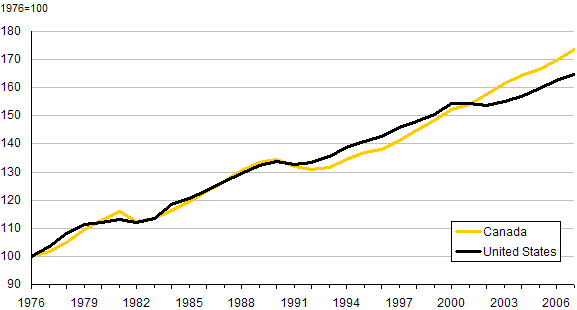Publications
The Canadian Labour Market at a Glance
Employment indexes, Canada and the United States
Archived Content
Information identified as archived is provided for reference, research or recordkeeping purposes. It is not subject to the Government of Canada Web Standards and has not been altered or updated since it was archived. Please "contact us" to request a format other than those available.
Employment trends diverged between Canada and the United States
-
Employment in Canada grew at twice the pace of that of the United States in the 2000s, at an annual growth rate of 2.0% versus 1.0%, respectively. The Canadian economy was also stronger during this period, with annual growth in Gross Domestic Product (GDP) of 2.5% compared with 2.2% for the United States. This trend is opposite to what occurred in the 1990s, when both employment and GDP were stronger in the United States than in Canada.
-
Both countries had major job losses in manufacturing, but declines were deeper and longer in the United States than in Canada. U.S. manufacturing employment plummeted by 21% from 1998 to 2007, versus a decline of 12% in Canada from 2000 to 2007. During the 2000 to 2007 period, Canadian employment growth was stronger than in the United States in the following industries: construction; trade; mining, oil and gas; utilities; business services and public administration.
-
The year 2007 was good for employment in Canada (up 2.3% from 2006), despite losses in manufacturing and forestry and logging. Employment growth was mostly in full-time work, in the public sector as well as in construction and mining, oil and gas. In contrast, in the United States, employment growth from 2006 to 2007 (+1.1%) was hampered not only by losses in manufacturing, but also by losses in construction and financial activities.
Chart P.1
Employment indexes of people aged 16 and over, Canada and the United States, 1976 to 2007

Note: Canadian data have been adjusted to approximate U.S. measurement concepts.
Sources: Statistics Canada, Labour Force Survey, and U.S. Bureau of Labor Statistics,
Current Population Survey.
- Date modified:
